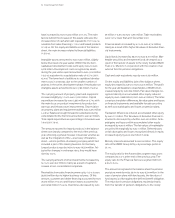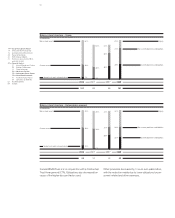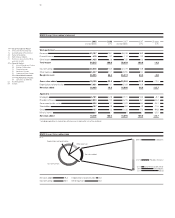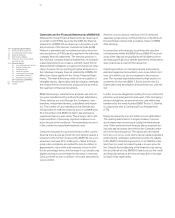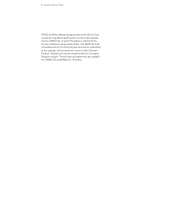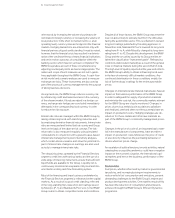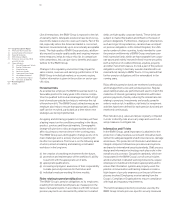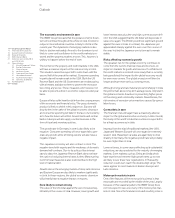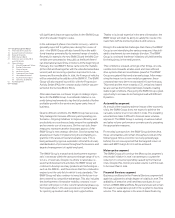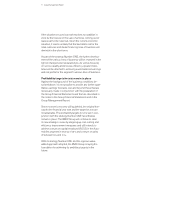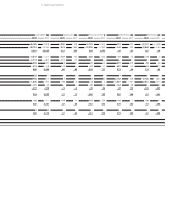BMW 2008 Annual Report Download - page 62
Download and view the complete annual report
Please find page 62 of the 2008 BMW annual report below. You can navigate through the pages in the report by either clicking on the pages listed below, or by using the keyword search tool below to find specific information within the annual report.63 Group Management Report
other words by increasing the volume of purchases de-
nominated in foreign currency or increasing the volume of
local production. In the short to medium term (i. e. at an
operating level), currency risks are hedged on the financial
markets. Hedging transactions are entered into only with
financial partners of good credit standing. It must be noted,
however, that the financial crisis has resulted in a deterio-
ration of the creditworthiness of many financial institutions
and set in motion a process of consolidation within the
banking sector which has not yet been completed. The
BMW Group takes account of these circumstances by
adjusting counterparty limits as deemed appropriate. The
nature and scope of such measures are set out in guide-
lines applicable throughout the BMW Group. A cash-flow-
at-risk model and scenario analyses are used to measure
exchange rate risks. These instruments are also used as
part of the process of currency management for the purpose
of taking business decisions.
As a general rule, the BMW Group reduces currency risk
by refinancing credit and lease business in the currency
of the relevant market. If funds are raised in a foreign cur-
rency, exchange rate hedges are concluded immediately
afterwards in the corresponding local currency in order
to reduce the risk exposure.
Interest-rate risks are managed within the BMW Group by
raising refinancing funds with matching maturities and
by employing derivative financial instruments. Interest-rate
risks are measured and limited both at country and Group
level on the basis of the value-at-risk concept. The risk-
return ratio is also measured regularly using simulated
computations in conjunction with a present-value-based
interest rate management system. Sensitivity analyses,
which contain stress scenarios and show the potential im-
pact of interest rate changes on earnings, are also used
as tools to manage interest rate risks.
The deposit business operated by the Financial Services
segment, credit lines with various banks and the use of a
wide range of financing instruments ensure that sufficient
liquid funds are available to the Group. Liquidity risk is
continuously monitored at a separate entity level and doc-
umented in a rolling cash flow forecasting system.
Most of the financing and lease business undertaken by
the Financial Services segment is refinanced on the capital
markets. As a result of its good credit standing, reflected
in the long-standing first-class short-term ratings issued
by Moody’s (P-1) and Standard & Poor’s (A-1), the BMW
Group is able to obtain competitive terms and conditions.
Despite all of those factors, the BMW Group was neverthe-
less not able entirely to extricate itself from the difficulties
facing the automobile sector. This is reflected in revised
long-term ratings published by the rating agencies: in
November , Standard & Poor’s lowered its long-term
rating from A+ to A, while Moody’s changed its long-term
rating from A1 to A2. Despite this development, the BMW
Group and the securities issued by its Group entities re-
tained the clas sification “investment grade”. Refinancing
conditions deteriorated markedly as a result of the general
crisis on financial markets during the second half of .
The high level of liquidity reported at the year-end reflects
the BMW Group’s ability to obtain refinancing funds even
in the face of extremely difficult market conditions. Any
continued deterioration in these conditions entails the
risk of further drops in ratings for the entire automobile
sector.
Changes on international raw material markets also have an
impact on the business performance of the BMW Group.
In order to safeguard the supply of production materials
and minimise the cost risk, the commodity markets relevant
for the BMW Group are closely monitored. Changes in
prices of precious metals (such as platinum, palladium
and rhodium), steel and other non-ferrous metals have an
impact on production costs. Hedging strategies are de-
cided
on for these metals and other raw materials as
part
of the BMW Group’s commodity management proce-
dures.
Changes in the price of crude oil, an important basic mate-
rial in the manufacture of components, have an indirect
impact on production costs. Moreover, the price of crude
oil also directly influences the purchasing behaviour of
drivers when fuel prices change.
An escalation of political tensions, terrorist activities, natural
catastrophes or possible pandemics could have a negative
impact on the economic situation, the international capi-
tal
markets and hence the business performance of the
BMW
Group.
Sector risks
Fuel prices, whether influenced by market or governmental
tax policies, and increasingly stringent requirements to
reduce vehicle fuel consumption and emissions, present
demanding challenges for the BMW Group’s engine and
product development activities. One manifest result of this
has been the reduction of consumption and emissions
achieved through the BMW Group’s Efficient Dynamics
programme.


